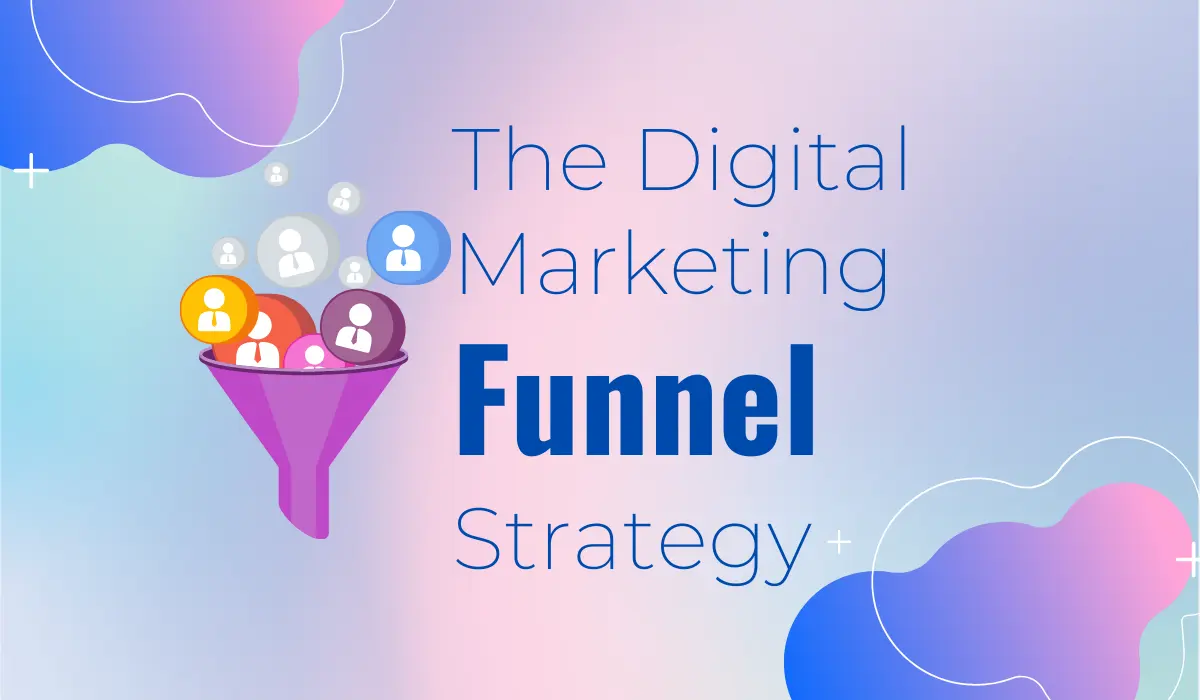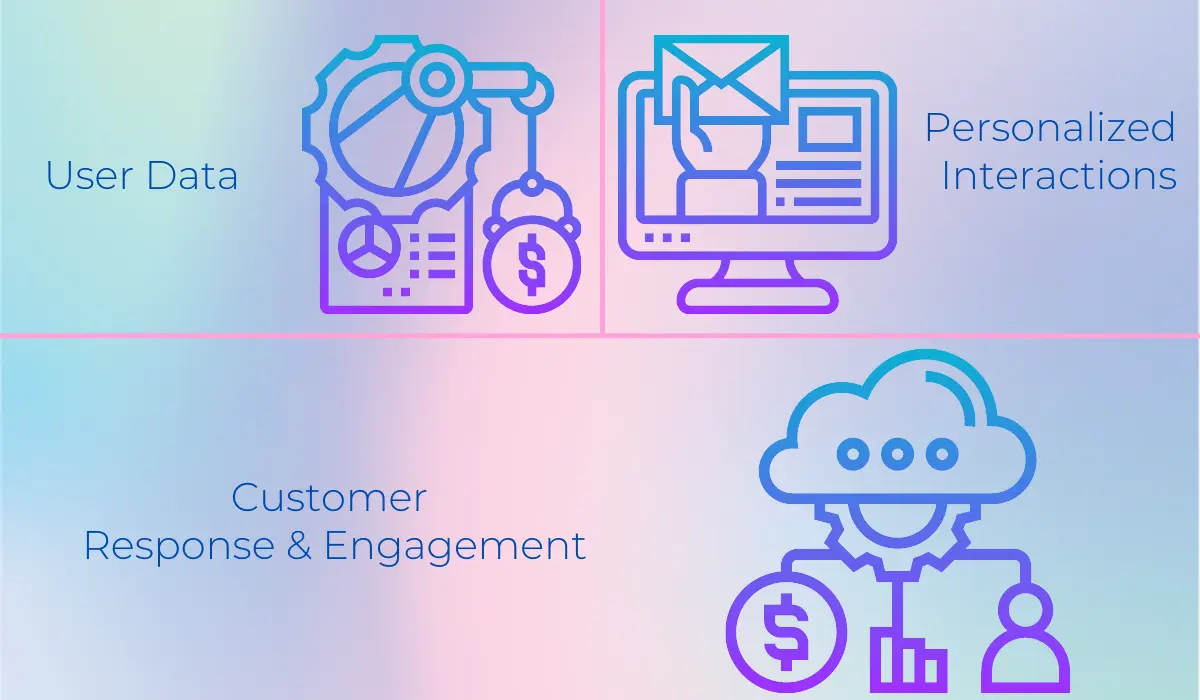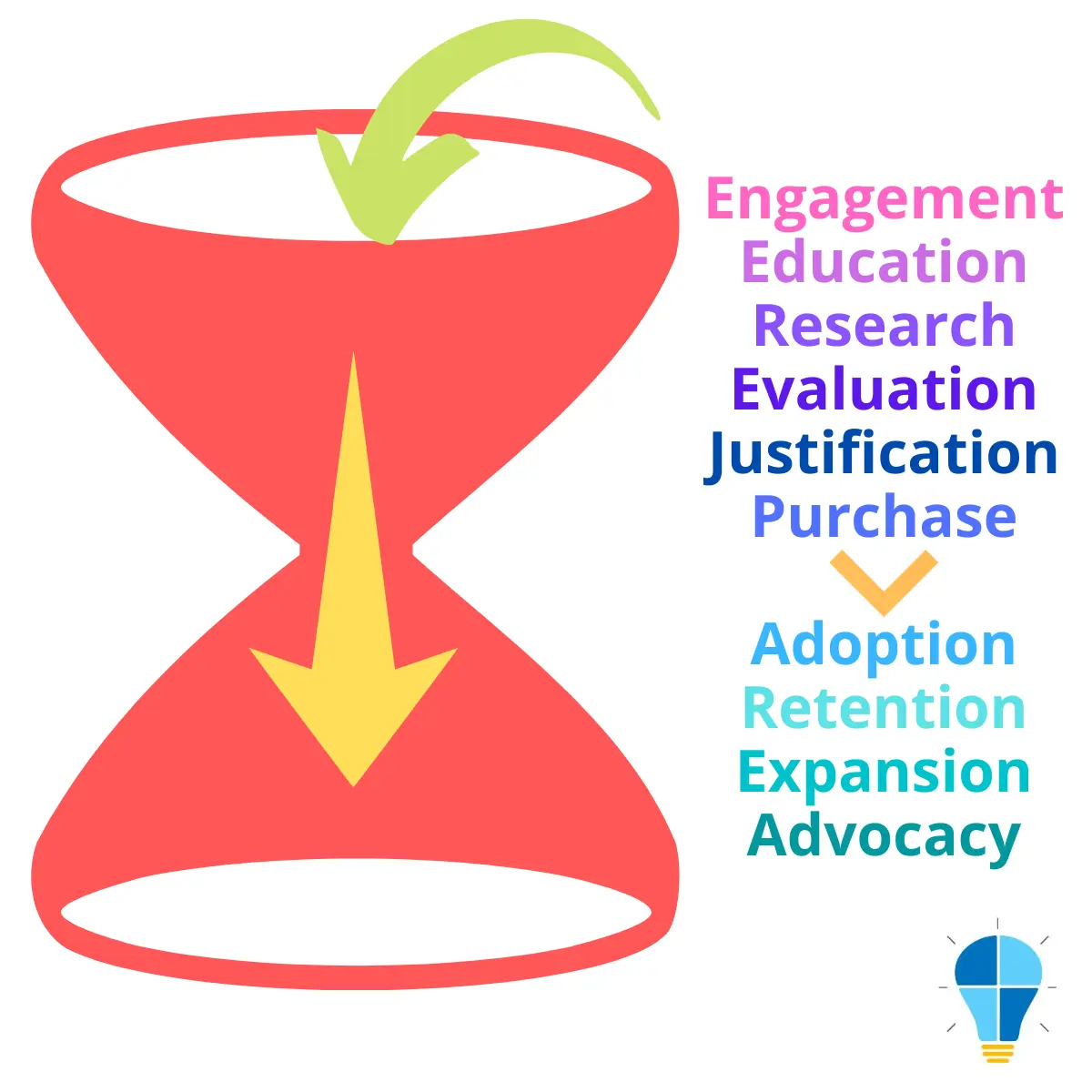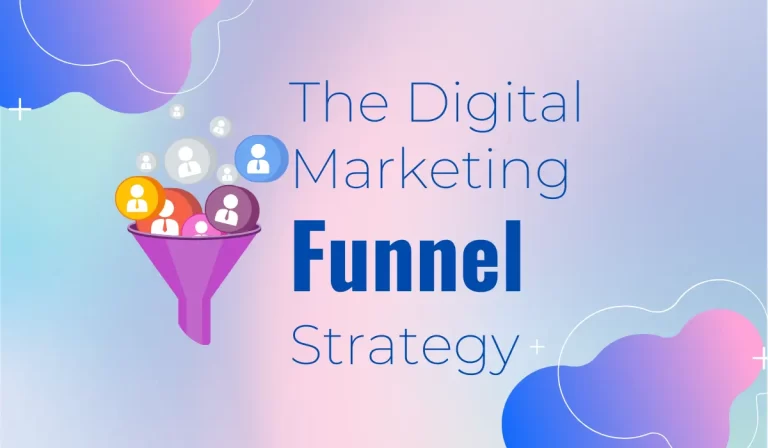Table Of Contents

Part 2: In-depth Online Marketing Funnel Strategy
The Details of A Digital Marketing Funnel

David Wallace
October 26, 2022
The Details of A Digital Marketing Funnel
In our previous article on Digital Marketing Funnel Strategies (we discussed the basics of what a marketing funnel is. As a little recap, digital marketing funnels include marketing automation and customer relationship management in order to accurately guide viewers into your business and to encourage them to return for future products and services. Beyond the surface level understanding, let’s dive into the details behind an online funnel strategy.
Marketing Automation and Customer Relationship Management
Marketing automation (Meyers) is a type of software that allows businesses to personalize information for customers through targeted, customized interactions made out of user data. The data is monitored with CRM (Customer Relationship Management), and sales funnels are then permitted to work with the buyer’s perspective in mind. Ultimately developing better customer response and user engagement.

When a company knows what their audience is looking for, they can target those potential buyers with what interests them. Most effectively, this happens through utilizing CRM and automated marketing and keeps the attention of the user. Showing buyers what they want and need is what encourages people through a digital marketing funnel.
How Do CTAs Help?
Viewers do their part of entering the marketing funnel and remaining on their customer journey from the time of awareness down to customer loyalty. Customers staying on track through the funnel can be encouraged by CTAs (Call To Actions). A CTA is the next action or step (Kenton) that businesses want viewers to take in the funnel.
CTA’s can be enticed by marketing automation. Engagements such as clicking on “email me,” “contact us,” and “buy” buttons can serve as an example of starting the next steps of the automation process and moving down the digital marketing funnel. The function of the funnel is to lead prospects in the right direction. CRM and marketing automation softwares help maintain user interests in your products and services in order to keep their attention on your business.
Marketing Funnels for B2B and B2C
There are two types of uses for a digital marketing funnel; Business-to-business (B2B) and business-to-customer (B2C) (Sassara). Business-to-business funnels are specific for capturing the attention of other businesses, while business-to-customer targets individuals. Though, regardless of target audience, the customer journey is generally in hopes of the same result; gaining and keeping users. By implementing a strategic series of steps to get viewers from the top of your funnel to the bottom, you can obtain customer attentiveness and push specified information to your viewers.

Digital Marketing Funnel Steps
The steps of any given funnel can vary from business to business for tailored results. Steps can also change depending on the desired type of strategy. Funnels can differ between Looping, Micro-Moments, or Hourglass (“How To Develop a Profitable Digital Marketing Funnel”) – which we’ll dive into later – but the general actions are explained below.
Marketing Tip
Know Your Audience
Before jumping into a sales funnel, you need to know your audience. Who is most likely to buy your product? What does your brand promote? What type of person was in mind while creating your service? What kind of messaging does your audience care about? If you aren’t sure, do research. You need to know the customer your brand exists for.
Before jumping into a sales funnel, you need to know your audience. Who is most likely to buy your product? What does your brand promote? What type of person was in mind while creating your service? What kind of messaging does your audience care about? If you aren’t sure, do research. You need to know the customer your brand exists for.
Target Your Audience
You need to target your audience. Once you know who your audience is, you can start targeting that group of people. Meaning, singling them out, and making sure those are the people coming in contact with your website, opposed to anyone who isn’t interested in your services or products.
You need to target your audience. Once you know who your audience is, you can start targeting that group of people. Meaning, singling them out, and making sure those are the people coming in contact with your website, opposed to anyone who isn’t interested in your services or products.
Cater To Your Audience
Tend to your customer’s wants and needs. If you know who your audience is, you can target them through various methods. You can show that select group of people what they’re missing out on. Inform your audience on what you have to offer and show them the solutions you have for their problems.
Tend to your customer’s wants and needs. If you know who your audience is, you can target them through various methods. You can show that select group of people what they’re missing out on. Inform your audience on what you have to offer and show them the solutions you have for their problems.
Awareness
The first step in any sales funnel is to bring awareness to your brand. As mentioned above, it’s the step where you should be putting your company in front of as many prospective customers as possible. Either through organic SEO, ads, social media or all three. Most viewers will search for something they need in hopes of finding it, but some customers don’t always know where to get that “thing” until an option is put in front of them.
Showcasing relevant information will help people become aware of what they need, and more importantly, what you offer. There are many ways to bring awareness to your brand. The most obvious avenues are promotions, social media posts and various forms of advertising. Paid ads (Peterson) are the most effective for brand awareness and lead generation. However, even though paid ads are great for initial awareness and conversions, you'll want to do a bit more to keep customers coming back and continue a long term reach.
Awareness includes leveraging social media influencer partners, furthering your brand reputation through online engagement, having great SEO, press through journalism or blogging (“How to Build a Full-Funnel Marketing Strategy in 2022”), utilizing video storytelling, creating a viewer in mind website, including audience pain points and solutions (Dimitriou), and so on. Any idea you have that puts your business on display for your audience to find, will add to the amount of awareness your products and services acquire.
Showcasing relevant information will help people become aware of what they need, and more importantly, what you offer. There are many ways to bring awareness to your brand. The most obvious avenues are promotions, social media posts and various forms of advertising. Paid ads (Peterson) are the most effective for brand awareness and lead generation. However, even though paid ads are great for initial awareness and conversions, you'll want to do a bit more to keep customers coming back and continue a long term reach.
Awareness includes leveraging social media influencer partners, furthering your brand reputation through online engagement, having great SEO, press through journalism or blogging (“How to Build a Full-Funnel Marketing Strategy in 2022”), utilizing video storytelling, creating a viewer in mind website, including audience pain points and solutions (Dimitriou), and so on. Any idea you have that puts your business on display for your audience to find, will add to the amount of awareness your products and services acquire.

Interest
After a viewer has become aware of your business, service, or product, the next step is to interest them in what they see. Sometimes “awareness” can be blurred together with “interest,” but they’re two separate steps. Awareness has to do with getting your brand in front of people, while interest is to show them the value of your brand so they stick with it.
When a customer reaches this stage, they are most likely conducting research on a few other brands besides yours. The opportunity presented is for your brand to keep the viewers interested in what you offer instead of in what your competitors offer. Your target audience will be comparing their options (Pathak et al.), so you want your business to stand out.
Give viewers the chance to appreciate what you’re showing them. Elevate the solutions to their problems or present the answers they’ve been searching for. Research your competitors, do they have any advantages over your business? Giving viewers the right solution will guide them to the next step in the marketing funnel.
When a customer reaches this stage, they are most likely conducting research on a few other brands besides yours. The opportunity presented is for your brand to keep the viewers interested in what you offer instead of in what your competitors offer. Your target audience will be comparing their options (Pathak et al.), so you want your business to stand out.
Give viewers the chance to appreciate what you’re showing them. Elevate the solutions to their problems or present the answers they’ve been searching for. Research your competitors, do they have any advantages over your business? Giving viewers the right solution will guide them to the next step in the marketing funnel.
Consideration
When viewers are interested in something, it doesn’t mean they’re going to automatically want it. Sometimes they will, other times they need some extra encouragement down the funnel. The main goal in this step is to keep their interest. The consideration phase is when potential customers could engage with your brand (VAIDHEESWARAN).
Targeting an audience isn’t a “one time and you’re out” type of deal. If your attempts seem like a failure the first few times, keep going. A part of the funnel strategy is a long term pursuit. Keep targeting your audience until they move to the following step. If you stop targeting them, they will find interest in another business like yours. To maintain their attention and ensure they are taking steps towards commitment, you have to keep showing them what they want with personalized engagement.
Targeting an audience isn’t a “one time and you’re out” type of deal. If your attempts seem like a failure the first few times, keep going. A part of the funnel strategy is a long term pursuit. Keep targeting your audience until they move to the following step. If you stop targeting them, they will find interest in another business like yours. To maintain their attention and ensure they are taking steps towards commitment, you have to keep showing them what they want with personalized engagement.

Desire/Intent
The best part of any digital marketing funnel strategy is when the consumer develops a connection to what’s being offered. An emotional connection (Brooks) will develop desire. The customer is not only interested but also actively engaged and pursuing your product, service, or brand with intent on purchasing.
The viewer is already considering your company. Moving forward, you want to keep their desire. They already want what you’re offering but need to keep being nudged in the right direction – down the funnel. The best thing to do here is to keep up with what your customer wants (through CRM software automations) and continue to provide them with reasons to engage. Anything that shows them how much they really need your product will encourage them towards a purchase.
The viewer is already considering your company. Moving forward, you want to keep their desire. They already want what you’re offering but need to keep being nudged in the right direction – down the funnel. The best thing to do here is to keep up with what your customer wants (through CRM software automations) and continue to provide them with reasons to engage. Anything that shows them how much they really need your product will encourage them towards a purchase.
Evaluation
By the time a person makes it to the evaluation stage of the funnel, they’re already convinced that your company has what they’re searching for. Since this is where they’ll make a final decision about buying (VAIDHEESWARAN) from you or not. Sometimes a viewer in this phase will jump straight to the bottom of the funnel, but in other circumstances buyers will get stuck here.
When an engaged viewer is stagnant in the evaluation phase, it primarily has to do with how they are comparing your business to another business that offers the same thing. As continuously mentioned, the consumer may need a little extra something from you. Something that will outweigh the other companies on their checklist.
With evaluation as a crucial part of the digital sales funnel, the viewer is only one step away from “purchasing.” Even so, they may still have doubts or further concerns about choosing your business. This is why they are still looking around and evaluating other businesses before making a decision. Maybe try positive reinforcements. Something as simple as lowering the shipping costs could lead to a conversion.
When an engaged viewer is stagnant in the evaluation phase, it primarily has to do with how they are comparing your business to another business that offers the same thing. As continuously mentioned, the consumer may need a little extra something from you. Something that will outweigh the other companies on their checklist.
With evaluation as a crucial part of the digital sales funnel, the viewer is only one step away from “purchasing.” Even so, they may still have doubts or further concerns about choosing your business. This is why they are still looking around and evaluating other businesses before making a decision. Maybe try positive reinforcements. Something as simple as lowering the shipping costs could lead to a conversion.

Action
If you give your viewers proper navigation, you’ll be able to guide them to their final destination in the sales funnel. This step takes them from “wanting” something to “having” it. By correctly delegating your call to actions (“How To Optimize Your Sales Funnel With Superior Calls-To-Action”), conversions and sales will do amazing.
Walk viewers through the last step of the digital funnel by giving them options to “buy now,” “sign up,” “see more” and so on. The viewer already wants what you’re offering. All you’re doing is making it easy for them to find and obtain it.
Walk viewers through the last step of the digital funnel by giving them options to “buy now,” “sign up,” “see more” and so on. The viewer already wants what you’re offering. All you’re doing is making it easy for them to find and obtain it.
Purchase/Conversion
After an action is taken on the buyer's part, you’ve successfully ushered a viewer to becoming a customer. They’ve made a final decision and now you have them as a new happy client. This is the phase where your prospective viewer makes their first purchase or requests your service. The journey might be over for them, but it’s just beginning for you
Retention
The last step is turning a one time buyer into a forever customer. Making sure that buyers don’t start getting what you’re offering from another business. Maintaining their interests and keeping retention basically relies on you repeating steps 2-6.

Those who make it to the bottom of the funnel become customers that you’ve successfully formed a relationship with through marketing. Not only does the customer become loyal, they also bring more viewers to your business, thanks to the personal experience they had with your brand. Retained customers are valuable organic promoters.
Types Of Sales Funnels
The top three types of digital funnel strategies used are described below.
1. Looping
Also known as the “Loyalty Loop,” (“How To Develop a Profitable Digital Marketing Funnel”) this marketing funnel aids first time customers into becoming looped buyers, who regularly “loops” back into a sales funnel as a returning customer.

2. Micro-Moments
“I want to know, go, do, and buy,” (“The basics of understanding key consumer micro-moments”) are the “micro-moments” at which this type of funnel strategy catches a viewers attention to draw them into a businesses’ space of expertise, products or services based on what the person is looking for in the moment.

3. hourglass
Probably the most popular digital funnel strategy, and the one we have primarily discussed. This type of funnel tries to target a broader audience for consumer retention, in hopes of making viewers curious and attentive to something they may not have been looking for in the first place, or drawing existing customers back into the funnel. Both the pre-purchase and post-purchase customer are focused on (“Digital Marketing Funnel: The Comprehensive Guide In 2022”). Which allows for long term engagement, brand trust, and relationship building.

We described the depth of a digital marketing sales funnel to give a good idea of how they work. Creating a digital marketing funnel strategy is one thing, maintaining, executing, and successfully getting people to the bottom of the funnel so they remain a customer is a process. It’s not something that happens over night, but it outweighs speedy sales tactics in the long run.
The nature of a marketing funnel is to create relationships with prospects so they don’t just buy something once and never again. You want customers to trust and tell others about your brand. Read our follow up blog post on Marketing Automation Mechanisms and CRMs (link part 3 blog post) to continue learning about what goes on behind the scenes of a properly functional digital marketing funnel.
The nature of a marketing funnel is to create relationships with prospects so they don’t just buy something once and never again. You want customers to trust and tell others about your brand. Read our follow up blog post on Marketing Automation Mechanisms and CRMs (link part 3 blog post) to continue learning about what goes on behind the scenes of a properly functional digital marketing funnel.
Resources
“The basics of understanding key consumer micro-moments.” Think with Google, https://www.thinkwithgoogle.com/consumer-insights/consumer-journey/micro-moments-understand-new-consumer-behavior/. Accessed 16 May 2022.
Brooks, Aaron. “Marketing Funnel Strategies: 5 Steps to Increase Sales in 2022.” Venture Harbour, 14 April 2022, https://www.ventureharbour.com/5-strategies-to-build-a-marketing-funnel-that-converts/. Accessed 14 June 2022.
“Digital Marketing Funnel: The Comprehensive Guide In 2022.” Page Builders Pro, 21 December 2021, https://pagebuilderspro.com/digital-marketing-funnel/#3_Types_of_Digital_Marketing_Funnel. Accessed 16 May 2022.
Dimitriou, Marilia. “Marketing Funnel: How To Build A Profitable One In 2022.” Moosend, https://moosend.com/blog/marketing-funnel/. Accessed 16 May 2022.
“How to Build a Full-Funnel Marketing Strategy in 2022.” Emotive, https://emotive.io/blog/how-to-build-a-full-funnel-marketing-strategy-in-2022. Accessed 16 May 2022.
“How To Develop a Profitable Digital Marketing Funnel.” Diggity Marketing, https://diggitymarketing.com/digital-marketing-funnel/. Accessed 16 May 2022.
“How To Optimize Your Sales Funnel With Superior Calls-To-Action.” Lilach Bullock, 28 December 2017, https://www.lilachbullock.com/sales-funnel-calls-to-action/. Accessed 27 April 2022.
Kenton, Will. “Call to Action (CTA) Definition - Marketing Essentials.” Investopedia, https://www.investopedia.com/terms/c/call-action-cta.asp. Accessed 31 May 2022.
Meyers, Sarah. “Marketing Automation in CRM.” Rolustech, https://www.rolustech.com/blog/marketing-automation-crm. Accessed 27 April 2022.
Pathak, Eshita, et al. “Sales Funnel Guide: How To Create A Successful One In 2022?” The Hustle Story, 10 May 2022, https://thehustlestory.com/sales-funnel/#4-2-interest-. Accessed 16 May 2022.
Peterson, Sarah. “Paid Advertising in 2022: What it is (& How it Works).” Smart Blogger, 16 February 2022, https://smartblogger.com/paid-advertising/. Accessed 8 June 2022.
Sassara, Chelsea. “B2B vs. B2C Sales Funnel: Know the Difference to Convert Your Audience.” LEARNING HUB, 2 November 2020, https://blog.vmgstudios.com/b2b-vs-b2c-sales-funnel-convert. Accessed 27 April 2022.
VAIDHEESWARAN, MURTHY. “The Marketing Funnel Strategy -2022.” QR Solutions, 4 February 2022, https://qrsolutions.com.au/the-marketing-funnel-strategy-2022/. Accessed 14 June 2022.
Brooks, Aaron. “Marketing Funnel Strategies: 5 Steps to Increase Sales in 2022.” Venture Harbour, 14 April 2022, https://www.ventureharbour.com/5-strategies-to-build-a-marketing-funnel-that-converts/. Accessed 14 June 2022.
“Digital Marketing Funnel: The Comprehensive Guide In 2022.” Page Builders Pro, 21 December 2021, https://pagebuilderspro.com/digital-marketing-funnel/#3_Types_of_Digital_Marketing_Funnel. Accessed 16 May 2022.
Dimitriou, Marilia. “Marketing Funnel: How To Build A Profitable One In 2022.” Moosend, https://moosend.com/blog/marketing-funnel/. Accessed 16 May 2022.
“How to Build a Full-Funnel Marketing Strategy in 2022.” Emotive, https://emotive.io/blog/how-to-build-a-full-funnel-marketing-strategy-in-2022. Accessed 16 May 2022.
“How To Develop a Profitable Digital Marketing Funnel.” Diggity Marketing, https://diggitymarketing.com/digital-marketing-funnel/. Accessed 16 May 2022.
“How To Optimize Your Sales Funnel With Superior Calls-To-Action.” Lilach Bullock, 28 December 2017, https://www.lilachbullock.com/sales-funnel-calls-to-action/. Accessed 27 April 2022.
Kenton, Will. “Call to Action (CTA) Definition - Marketing Essentials.” Investopedia, https://www.investopedia.com/terms/c/call-action-cta.asp. Accessed 31 May 2022.
Meyers, Sarah. “Marketing Automation in CRM.” Rolustech, https://www.rolustech.com/blog/marketing-automation-crm. Accessed 27 April 2022.
Pathak, Eshita, et al. “Sales Funnel Guide: How To Create A Successful One In 2022?” The Hustle Story, 10 May 2022, https://thehustlestory.com/sales-funnel/#4-2-interest-. Accessed 16 May 2022.
Peterson, Sarah. “Paid Advertising in 2022: What it is (& How it Works).” Smart Blogger, 16 February 2022, https://smartblogger.com/paid-advertising/. Accessed 8 June 2022.
Sassara, Chelsea. “B2B vs. B2C Sales Funnel: Know the Difference to Convert Your Audience.” LEARNING HUB, 2 November 2020, https://blog.vmgstudios.com/b2b-vs-b2c-sales-funnel-convert. Accessed 27 April 2022.
VAIDHEESWARAN, MURTHY. “The Marketing Funnel Strategy -2022.” QR Solutions, 4 February 2022, https://qrsolutions.com.au/the-marketing-funnel-strategy-2022/. Accessed 14 June 2022.
About The Author
David to write something about himself for his author bio...
